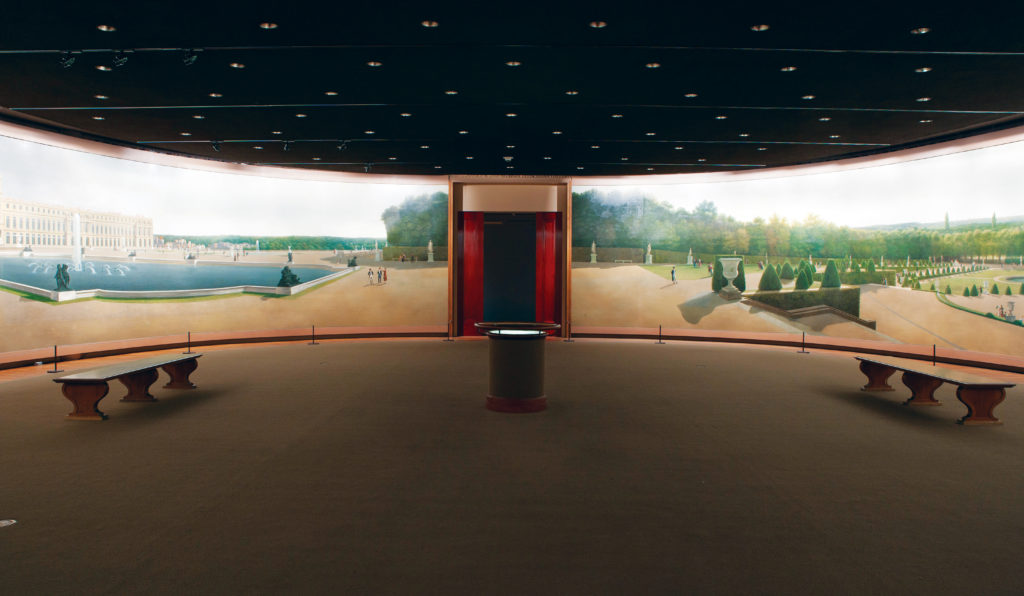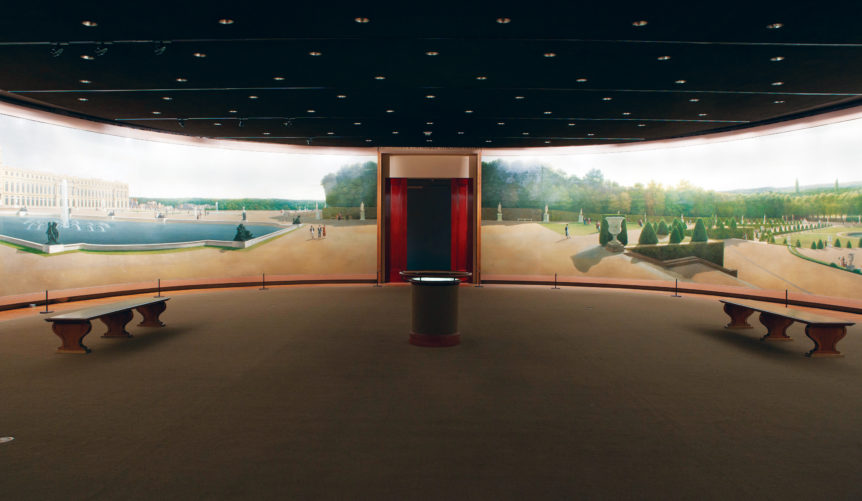
Panoramic view of the Palace and Gardens of Versailles by John Vanderlyn, 1818–1819, installed at the Metropolitan Museum of Art. Gift of the Senate House Association, Kingston, New York.
If you have your computer or smart phone handy and aren’t already familiar with Nate DiMeo’s podcast, “The Memory Palace,” hasten to the Metropolitan Museum of Art’s website. A writer, storyteller, and American history enthusiast, DiMeo has spent a lot of time this past year in the American Wing as the museum’s artist-in-residence, part of its MetLiveArts program. You might not agree with everything he says, but DiMeo’s eight podcasts are more than entertaining and informative; they make you think further than you might after reading wall labels—or even whole articles—on any one of his given subjects. These range—or start—from a simple mold-blown glass bottle to the ballroom from Gadsby’s Tavern in Alexandria, Virginia, to the Wing’s entire collection as embodied in the Luce Center’s open storage. That’s the subject of one of the last episodes, which are scheduled to air just about the time you should receive this issue.
When asked how he chooses his subjects, DiMeo says, “I am not just looking for interesting anecdotes or factoids, I’m looking to be moved, I’m looking to draw some connection between a moment or figure or phenomenon from the past and how we live today. I went to the Met—literally, repeatedly—hoping to find things that moved me or fascinated me or helped me understand the world a little better. On some level, that’s all I’m doing any time I go to a museum or gallery or movie or whatever. But with the residency, I had the wonderful opportunity to be able to turn to the curators to guide me deeper into a work. It was their passion and ability to unpack and illuminate an artwork that ultimately helped me get inspired and draw connections.”
“Sometimes,” he says, “as with episodes like ‘One Bottle, Any Bottle’ and ‘If You Have to Be a Floor,’ the piece would come in a rush. Other times it would take weeks to crack. The one about John Vanderlyn’s Versailles panorama was a bear. I knew there was a story there. But I couldn’t figure out what it was about, beyond a solid anecdote. Finding some deeper meaning—the thing that turns an anecdote into a story—and finding a structure through which to tell it, took many days and many drafts. It was by far the most challenging, but is ultimately one that I think is the most successful.”
“I thought a long time about the Shaker period room,” he adds, “but I could never quite make it work. Ultimately, though, I wound up incorporating some of its better ideas and some of its animating spirit into the piece about the Alexandria ballroom. That one is a particular favorite. It gets at, I think, a central idea that I brought with me into my residency—that a museum is a living place. That despite all the best intentions of its founders and curators and its architects and gallery designers, visitors are going to find what they will in those spaces. They’re going to like what they like. They’re going to bring their own interpretations. I think that piece does a good job both articulating that and providing its own fresh and surprising perspective.”
Sylvia Yount, the Lawrence A. Fleischman Curator in Charge of the American Wing, says the Memory Palace program has added enormously to the interpretation of the collections, allowing “curators, patrons, and visitors alike to consider them in more nuanced ways. Recently, we added signs to the galleries that highlight the episodes, ensuring they will be available to visitors when they’re in front of the objects. We’re getting a great response.”
By the way, the Met episodes form but a small fraction of DiMeo’s Memory Palace series of podcasts, drawn from American history writ large and small. They’re all well worth a listen.

